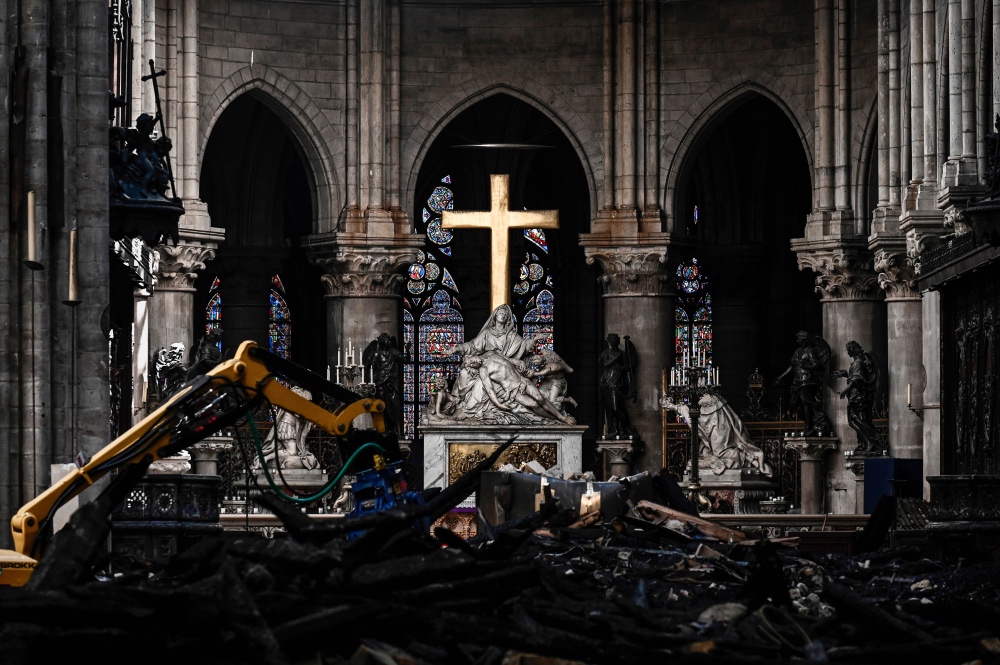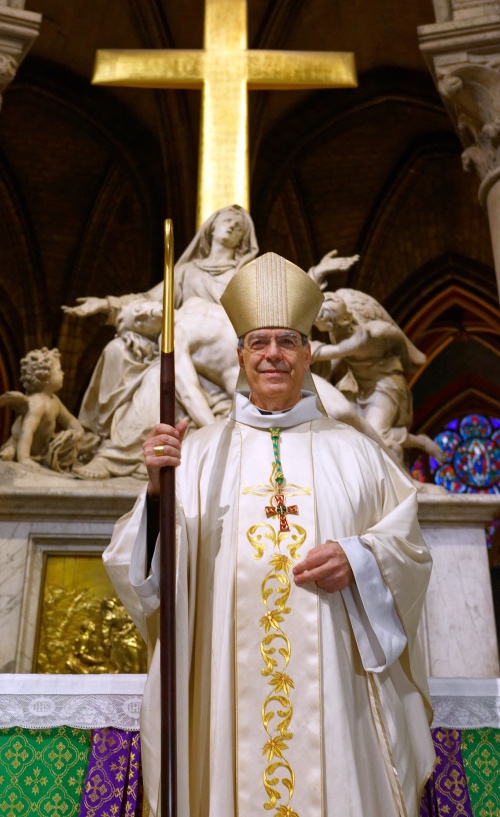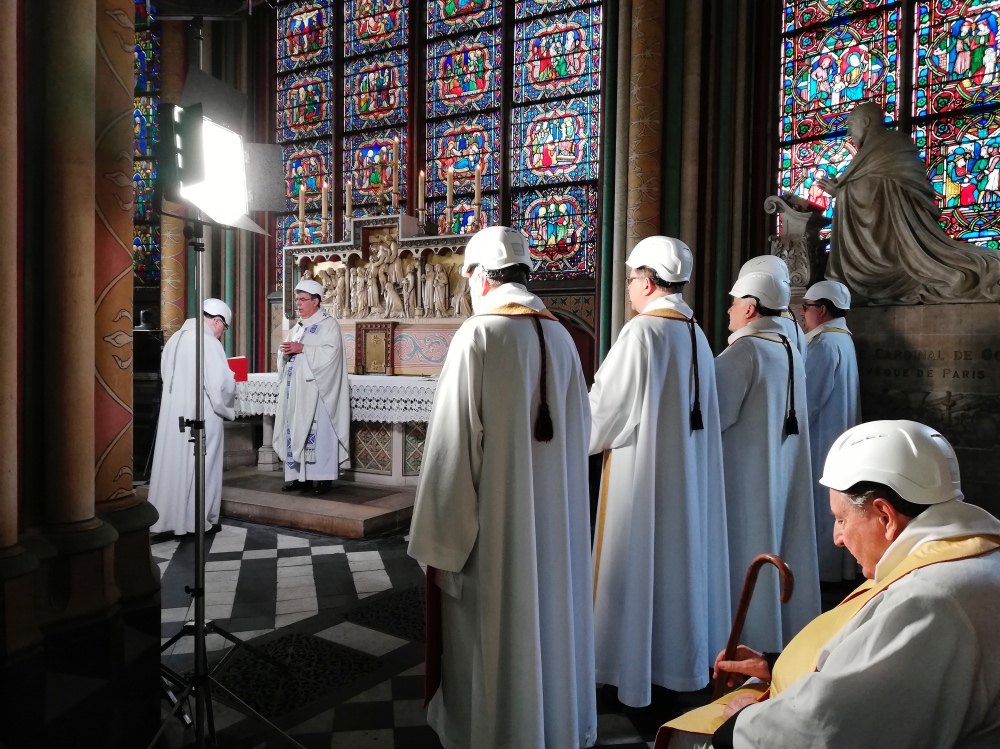
Catholic Archbishop of Paris MICHEL AUPETIT explains why Notre Dame’s purpose should be as it ever was – a place of worship and a house of prayer…
Via RNS
One year after the fire that nearly destroyed Notre Dame Cathedral, some are asking what purpose the cathedral should serve once it is fully restored.
Notre Dame is a vessel that has steered its way through the centuries. It is the repository of the history of our forefathers. It keeps our eyes turned toward the kingdom and invites us on a pilgrimage, preventing history from foreclosing the illusion of worldly salvation in favour of some notion of “progress” that runs frenetically toward the void.

A machine removes rubble below the Pieta sculpture and a cross inside the Notre Dame Cathedral on 15th May, 2019, in Paris. PICTURE: Philippe Lopez/Pool via AP.
When we ask, What is my destination? Where shall I go? To whom shall I turn, the cathedral’s arrow of stone, rising in the heart of the city, reminds us that we are each made for God. It lifts our hearts toward the reality above and unifies the city. It is both Paris’ summit and the door to heaven.
Babylon, the prideful city, “the lair of devils, and the den of every foul spirit”, as it is written in the Book of Revelation, must become Jerusalem, the holy city, where, as Psalm 122 says, “all together are but one”. In the moments of greatest tragedy the cathedral is our common refuge where we can mourn, where we can plead our cause. In our most joyful moments the cathedral is where we offer up our praise and our thanksgiving.

Archbishop of Paris Michel Aupetit. PICTURE: Y Boschat
“In the moments of greatest tragedy the cathedral is our common refuge where we can mourn, where we can plead our cause. In our most joyful moments the cathedral is where we offer up our praise and our thanksgiving.”
We must direct our steps toward her, a beautiful lady built of stone, to rediscover the meaning of the city, to know we are not just isolated individuals, insatiably demanding our “rights.” Instead we are a people called to communion, conscious of our duties, first and foremost to be our “brother’s keeper.”
But we can’t truly look after your brother without being aware of serving something higher. The greatness of our work lies in uniting people in their quest for transcendence. For Christians, the face of God reveals itself in the face of Jesus Christ, the word made flesh, the son of the carpenter who gives human labour its unsurpassable dignity.
Medieval man was a complete stranger to the idea of “art for art’s sake”. He worked for centuries for the eternal in cheerful abnegation, happy to be one of the “unworthy servants” that Luke wrote about in his Gospel. Those who built Notre Dame didn’t sign their work in some narcissistic wish to make a name for themselves; they served something higher, in the firm belief that they belonged to a community where every member was dedicated to the same mystery.
The cathedral is the mirror of the cosmos and the reflection of heaven, an immense chef d’oeuvre created by innumerable artisans, each with their own skill and talent. Notre Dame is dedicated to helping us to achieve communion with one another and with God.
The cathedral is also an invitation addressed to the heart of hearts of each individual. “Citadel,” wrote Antoine de Saint-Exupéry, “I will build you in the heart of man.” We enter the cathedral for a rebirth, in search of the ultimate meaning of life. Existence is no longer a frantic race against death (which wins) but an invitation to live each day in hope everlasting.
On entering Chartres cathedral, also named for Our Lady, pilgrims work their way through a large labyrinth outlined on the floor of the nave before approaching the cathedral’s focal point: the altar representing the risen Christ. Disoriented by sin, distracted by the constant buzz of empty thoughts, pulled in every direction by the solicitations of the world, we humans must, like the prodigal son, look deep down inside to discover where the true bread of life is. Only the lost can be found. Only the hungry can be satiated.
Notre Dame also represents Bethlehem, which means “the house of bread.” Not the bread of consumerism which weighs so heavily on the disenchanted, stuffed with “vast amounts of things which only incite the desire for still more things,” but rather that of the Beatitudes from the Sermon on the Mount: “Blessed are those who hunger and thirst for justice, for they will be satisfied.”
In the West we are obsessed with the self, so terrified by its demise that we have forgotten the taste of freedom. The cathedral stands in the city like the mystery of the cross, telling us that the paths of Earth are the path to heaven. Beyond the grave lies life’s true light, and real liberty. As long as we are under the spell of death we are miserable slaves. But “if Christ has liberated us, it is so that we be truly free,” Paul writes in his letter to the Galatians.

The Archbishop of Paris, Michel Aupetit, second left, leads the first Mass in a side chapel, two months after a devastating fire engulfed the Notre Dame Cathedral, on 15th June, 2019, in Paris. PICTURE: Karine Perret, Pool via AP.
The cathedral is undeniably a cultural landmark, available to all, beyond its affiliation to a specific community. Its splendor attracts many kinds of people, all of whom have the right to delight in its beauty. But the cathedral is much more than that. It is above all a place of worship. “Culture” is no protection against barbarity. How many mass murders and ideologues have been extremely cultured and educated in our best universities? Comrade Duch, the Khmer Rouge executioner, could recite Alfred de Vigny’s poem The Death of the Wolf by heart.
Above all, the cathedral is a “house of prayer for all nations” as we read about in the Book of Isaiah. The bishop seated there must be a servant of the unity of all, of “every tribe and language and people and nation,” according to the vision of Revelation. This unity shapes us into a people conscious of our common calling to the glory of heaven, not just the crowd in the consumer society, out for the cultural entertainment of mass tourism.
The “mother church” of the city, along with Christ, raises us up to the glory of the father in the unity of the Holy Spirit. The cathedral speaks to believers and nonbelievers alike, all on the threshold of the same mystery, all dazzled by the splendor of its beauty. We keep the faith only by constantly searching for it; our unbelief must be put into question by our thirst for meaning, the foremost desire of humankind.
So, what kind of cathedral will we have for the 21st century? The one we have always had, fulfilling the purpose for which it was built: the praise of God and the salvation of humankind. Let Notre Dame remain faithful to its mission, or she will lose her soul. May it always be the mysterious temple of the presence of our Lord, inviting each of us on pilgrimage. Let everyone come to look for the face of God “without money, without having to pay anything,” as Isaiah said. Let all who desire it come here to draw upon the waters of the true source of life.
The Most Rev Michel Aupetit is the Archbishop of Paris. This article was first published in the French newspaper La Croix.





